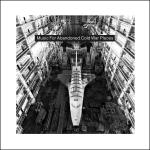V/A: Music For Abandoned Cold War Places

Purchase
Data
Tracks
- Grey Frequency: Building X6
- Joel Gilardini: Doomsday Clock
- HLER: ARK D-0 Mirrored Floor
- vÄäristymä: Checkpoint Charlie
Description
Since the 1978 Brian Eno album Music For Airports, subsequent attempts to produce music to create sonorous ambient textures and/or to describe environments through sound have been numerous. With this present compilation, curated by Raffaele Pezzella (Sonologyst), ZeroK (in collaboration with, Gavin Morrow , Joel Gilardini, Esa J. Ruoho, Heikki Lindgren, Andrés Faliu, Dani Kloob, Adriano Ragni, Matteo Scaioli, Evgeny Pustota, Valter Abreu, Jarko M. Hedenius, Janne Liimatainen, Jeton Hoxha, James Keeler and Wil Claeys) provide sound descriptions of abandoned Cold War places, as part of a wider project focused on abandoned, decommissioned, or even vanishing places. As the decades pass these places will become icons of past ages, existing somewhere between history and modern myth. They currently occupy a Ballardian mental space where reality cannot be distinguished from ghostly parallel dimensions.
Reviews
V/A: Music For Abandoned Cold War Places: Merchants of Air Review
The sound mapping compilations of the Italian Unexplained Sounds Group label offers new and interesting electronic sounds from all over the globe. Their sub-label ZeroK has released a collection of more electronic resonances definitely worth listening to in our opinion.
When we noticed which artists contributed on Music For Abandoned Cold War Places, we were very sure this wasn’t just horse shit. With the most interesting among underground dark ambient artist gathered on this album, we were already certain about a high quality result. This compilation is curated by Raffaele Pezzella (Sonologyst) and provides sound structures inspired by abandoned places from the almost forgotten Cold War period.
The album sweats tension, darkness, and has strange but vibrant vibrations that translate an almost ancient desolation of a world on the brink of nuclear disaster. Music For Abandoned Places literally takes us on a remarkable sound journey between history and modern mythology. All the artists have done a fantastic job of looking deep into their talent and creative afflatus. This project is a part of a wider conception focused on derelict, dismantled, or even vanishing places.
The Music For Abandoned Cold War Places anthology goes beyond standard dark ambient tunes. We were launched with experimental and eerie dark ambient, murky drones, sound effects of sirens, registrations of Geiger counters and bizarre echoes of nuclear poisoning. The cooperative artists on this awesome release are: Grey Frequency, Joel Gilardini, HLER, Phalioo, Kloob, Super8music, SÍLENÍ, Psionic Asylum, vÄäristymä, Jeton Hoxha, WILT and Chronodepth.
With no doubt this album could be the start of a new dark ambient approach inspired by ghostly military places disguised in scratching soundscapes coming from unknown dimensions. These twelve pieces of dark electronic art are the perfect soundtrack to hide in an old atomic shelter and stay until the global virus problem is vanished. Music For Abandoned Cold War Places is also available on CD. Buy or die!
Patsker
V/A: Music For Abandoned Cold War Places: Side-Line Reviews
REVIEW
V/A Music for Abandoned Cold War Places (Album – ZeroK)
Genre/Influences: Dark-Cinematographic, Dark-Ambient, Experimental.
Format: Digital, CD.
Background/Info: ZeroK is a sub-division of the Italian label Unexplained Sounds Group. This compilation is a conceptual release inspired –as indicated in the title, by abandoned Cold War places. Twelve artists have been invited to re-create the particular ambiance hanging over these places.
Artists: Grey Frequency, Joel Gilardini, HLER - Heikki Lindgren & Esa Ruoho, Phalioo, Kloob, Super8musik, SÍLENÍ, @Psiconic Asylum, vÄäristymä, Jeton Hoxha, WILT and Chronodepth.
Content: The twelve tracks are very efficient in their genre, but especially in the creation of the sphere we might all imagine hanging over such places of despair. Most of the compositions create a Cinematographic impression. It’s a ghost-like experience, sounding rather apocalyptic and minimalistic. Cold electro signals and diversified field recordings are progressively awakening the imagination of the listener.
+ + + : The theme serving as concept has clearly inspired most of the artists. It has been reinforced by some of the track titles like “Pripyat”, “Checkpoint Charlie”, “Decommissioned Architecture” and “Doomsday Clock”. I instantly got the sensation watching a documentary about the desolation of Chernobyl after the nuclear accident. Life has been taken away and replaced by an eternal silence. But this silence is constantly disturbed by natural elements like wind, water. Icy electronic signals and dark sound waves create a ghost-like effect; the sensation of visiting a ghost town, which is perfectly illustrated by the front cover of the album. My favorite cuts are the ones by vÄäristymä, Joel Gilardini and WILT. This compilation also is an opportunity to discover less familiar artists.
- - - : Some passages are a little less too Experimental to my taste, but globally speaking this compilation creates a compact result.
Conclusion: This compilation sounds as a true sonic documentary; you get the music and have to imagine the story.
Best bands: vÄäristymä, Joel Gilardini, WILT, Phalioo, Psionic Asylum.
Rate: (7½).
Label: www.facebook.com/ZeroK-103649114533137
V/A: Music For Abandoned Cold War Places: AmbientBlog Review
Released on Zero K, a sublabel of the Unexplained Sounds Group, and curated by Raffaelle ‘Sonologyst’ Pezzella, this compilation presents twelve “sound descriptions of abandoned Cold War places, as part of a wider project focused on abandoned, decommissioned, or even
vanishing places”.
The nature of these places may vary, but all of their associations are as cold, deserted, and desolate as the cover image (Soviet space shuttles in a huge abandoned hanger in Baikonur, Kazakhstan) promises. Some of the locations are widely known (Checkpoint Charlie, Pripyat, Three Mile Island), others aren’t. This is also true for the performers: only a few are vaguely familiar names to me.
But the compilation definitely delivers what it promised: 65 minutes of dark industrial sounds describing places that “will become icons of past ages, existing somewhere between history and modern myth, [which] currently occupy a Ballardian mental space where reality cannot be distinguished from ghostly parallel dimensions”.